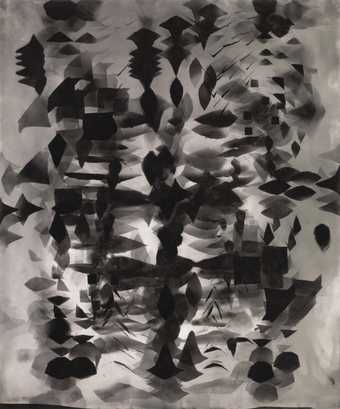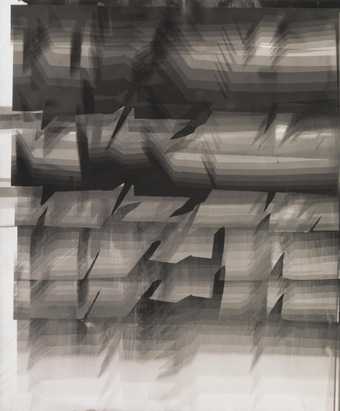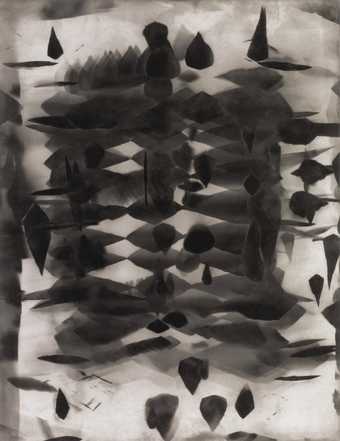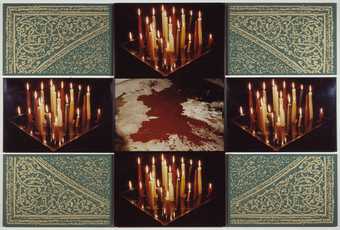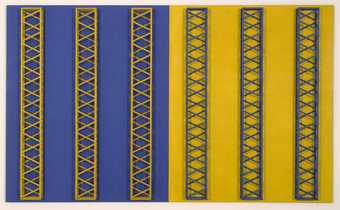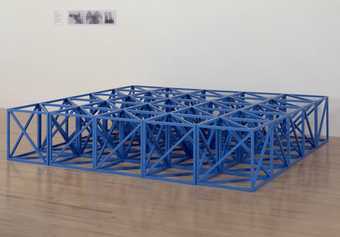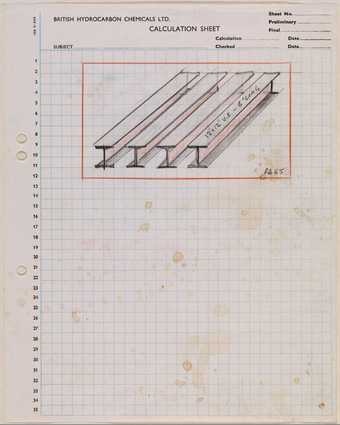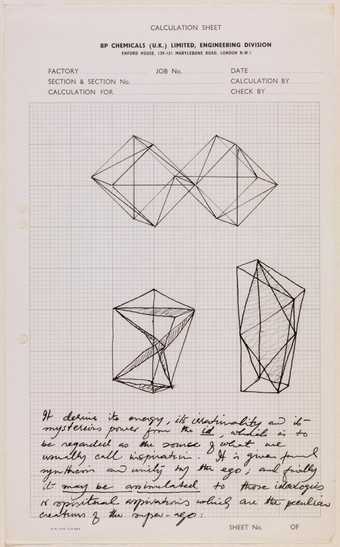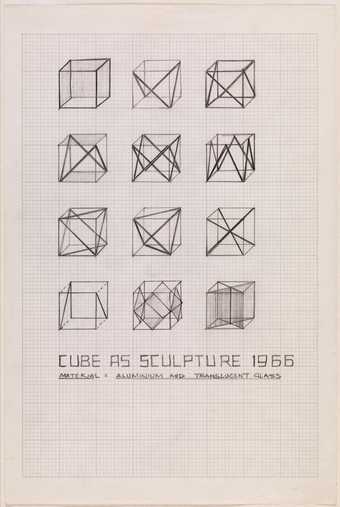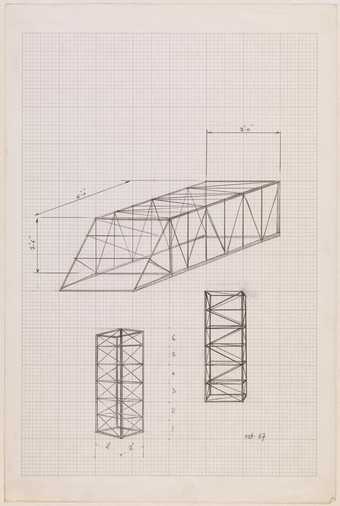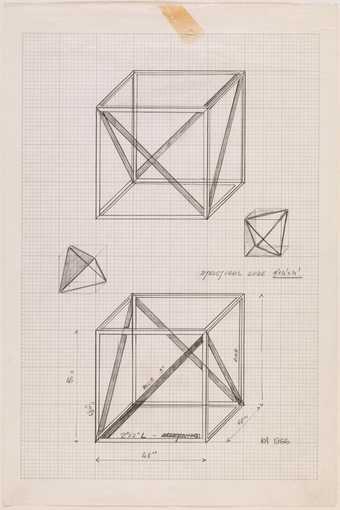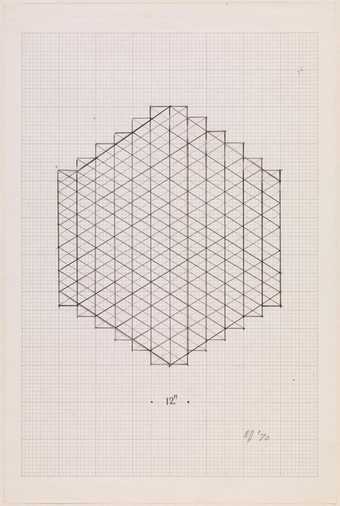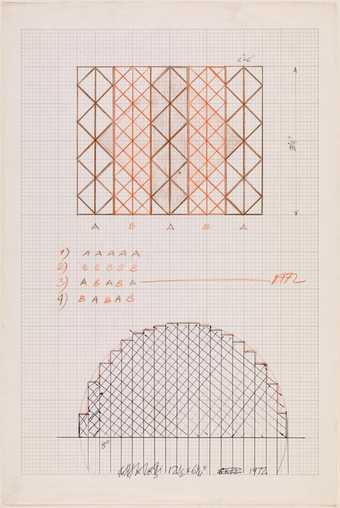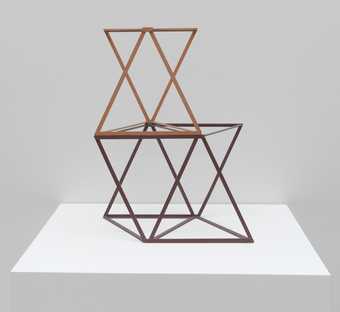In Tate Liverpool
- Artist
- Rasheed Araeen born 1935
- Medium
- Painted wood
- Dimensions
- 1830 × 610 × 460 mm
- Collection
- Tate
- Acquisition
- Presented by Tate Members 2007
- Reference
- T12409
Summary
Rang Baranga 1969 is a vertically oriented rectangular painted wooden sculpture by the British-Pakistani artist Rasheed Araeen. It consists of an intersecting lattice structure composed of eight individual columns that are painted in a sequence of contrasting colours – blue, orange, red and yellow. This sequence of colours begins on one side of the work and is repeated in reverse order on the other.
Trained as a civil engineer in Karachi, Pakistan, Araeen moved to the UK in 1964, and he made Rang Baranga five years after this move, when he was living in London. Supporting himself financially by working as an engineering assistant for British Petroleum, Araeen had no formal education in sculpture. The lattice structure employed by Araeen in Rang Baranga and other works such as 3Y + 3B 1969 (Tate T12408) displays a clear connection to the artist’s engineering background, but it has also been compared by the art historian Paul Overy to the repeated geometric patterns found in Islamic art and architecture in Araeen’s native Pakistan (see Overy 1994, p.7). However, the artist has stated that his use of the lattice relates not only to architectural and engineering structures, but makes reference to forms in early twentieth-century modernist art – Russian Constructivism and Dutch De Stijl in particular – and the utopian ideologies that accompanied those movements (see Overy 1994, p.7).
The employment of the lattice structure in combination with the use of contrasting colours creates an optical illusion within the work that makes Rang Baranga (an Urdu term meaning ‘of many colours’) appear to undulate or spiral when encountered in the gallery space – an effect not present in the largely monochromatic sculptures of Araeen’s American minimalist contemporaries, such as Sol LeWitt and Robert Morris. (See, for instance, Sol LeWitt, Two Open Modular Cubes/Half-Off 1972, Tate T01865, and Robert Morris, Untitled 1965, reconstructed 1971, Tate T01532.) As Tate curator Andreas Leventis has observed, ‘The use of different colours in Rang Baranga … evokes the rippling movement of fire or water, an effect that is intensified as the viewer moves around the work’ (Leventis in Tate Britain 2007, p.8). Araeen’s structures share a formal resemblance to the frame-based sculptures of LeWitt (see, for instance, Open Geometric Structure 3 1990, Lisson Gallery, London), but unlike LeWitt’s work, Araeen’s structures also incorporate diagonal and orthogonal elements.
Although operating within the language of minimalism, Araeen’s works also departed from many of his contemporaries through their reliance on utilitarian materials (such as prefabricated lattice and acrylic house paint) and their kinetic and interactive qualities. According to the art critic and historian Patricia Bickers, the use of the lattice was intended to break down minimalist hierarchies, specifically the Dutch abstract painter Piet Mondrian’s (1872–1944) emphasis on the use of pure colour, straight lines and gridded forms (see Patricia Bickers, ‘From Object to Subject’, in From Modernism to Postmodernism, Rasheed Araeen, A Retrospective: 1959–1987, exhibition catalogue, Ikon Gallery, Birmingham 1988, unpaginated). Araeen saw Mondrian’s resistance of the diagonal and reliance on vertical and horizontal lines as an effort to preserve tension and a refusal to reconcile opposites. However, Araeen’s experience as an engineer, suggests Bickers, ‘taught him the power of the diagonal to resolve tension without any loss of strength’ (Bickers 1988, unpaginated).
Rang Baranga formed part of the retrospective exhibition Minimalism and Beyond: Rasheed Araeen at Tate Britain, which was held from April to August 2007 at Tate Britain, London. In the exhibition’s catalogue, Leventis identified Araeen as a ‘pioneer of Minimalist sculpture in Britain’, but one whose contribution had until that point remained largely unrecognised (Tate Britain 2007, p.1). When Araeen visited the influential exhibition The Art of the Real at the Tate Gallery in 1969, which had travelled from the Museum of Modern Art, New York, and featured the work of American minimalist sculptors such as Morris and Donald Judd, he was already producing his own experiments in minimalist form, such as Rang Baranga. Yet Araeen’s work has often been discussed in art historical studies in relation to postcolonialism rather than minimalism. This is partly due to the near invisibility of black and Asian artists within twentieth-century Western art history and visual culture and the fact that Araeen produced increasingly political work during the 1970s and 1980s as a means of addressing this lack of visibility.
Further reading
Paul Overy, ‘The New Works of Rasheed Araeen’, in Rasheed Araeen, exhibition catalogue, South London Gallery, London 1994, pp.5–20.
Minimalism and Beyond: Rasheed Araeen at Tate Britain, exhibition catalogue, Tate Britain, London 2007, p.8.
Rasheed Araeen, ‘Rasheed Araeen: Rang Baranga 1969’, interview with Andrew Wilson and Melanie Rolfe, Tate Research, London, 9 July 2008, http://www.tate.org.uk/context-comment/video/rasheed-araeen-rang-baranga, accessed 8 May 2015.
Judith Wilkinson
May 2015
Supported by Christie’s.
Does this text contain inaccurate information or language that you feel we should improve or change? We would like to hear from you.
Display caption
After relocating to London from Karachi, Pakistan, in 1964, Araeen was struck by the work of the British sculptor Anthony Caro and decided to devote himself full-time to sculpture. Rather than following Caro’s example of a compositionally driven practice, Araeen decided that symmetrical configuration should form the basis of a new kind of sculpture. Formally Rang Baranga resembles the structures of Sol Lewitt’s open minimalist sculptures, but unlike the American artist’s, Araeen’s forms incorporate diagonal and orthogonal elements which refer in part to Islamic art but more importantly point to his training and practice as an engineer.
Gallery label, September 2016
Does this text contain inaccurate information or language that you feel we should improve or change? We would like to hear from you.
Explore
- abstraction(8,615)
-
- non-representational(6,161)
- formal qualities(12,454)
-
- pattern(358)
- repetition(391)
You might like
-
Nalini Malani Untitled I
1970/2017 -
Nalini Malani Untitled II
1970/2017 -
Nalini Malani Untitled III
1970/2017 -
Rasheed Araeen Bismullah
1988 -
Rasheed Araeen 3Y 3B
1969 -
Rasheed Araeen Zero to Infinity
1968–2007 -
Rasheed Araeen Drawing for Sculpture
1965 -
Rasheed Araeen Drawing for Sculpture
1968 -
Rasheed Araeen Drawing for Sculpture
1966 -
Rasheed Araeen Drawing for Sculpture
1967 -
Rasheed Araeen Drawing for Sculpture
1966 -
Rasheed Araeen Drawing for Sculpture
1970 -
Rasheed Araeen Drawing for Sculpture
1965 -
Rasheed Araeen Drawing for Sculpture
1972 -
Rasheed Araeen Lovers
1968


